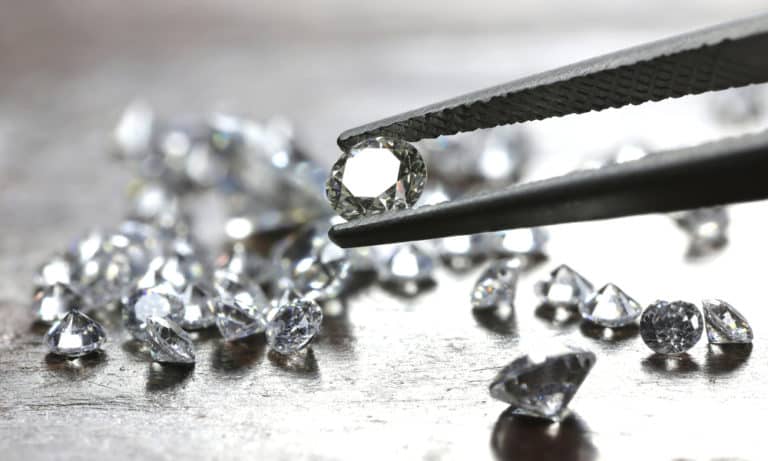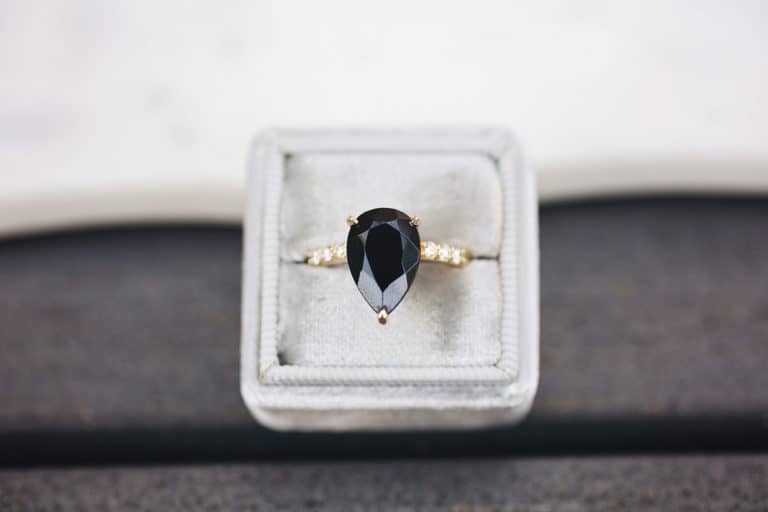
Are you looking for the best deal on a dazzling diamond? If so, you’ve probably come across an enhanced diamond at some point.
Enhancement impacts a diamond’s value and quality, so most jewelers (the good ones) will disclose if what you’re looking at is an enhanced diamond.
What exactly is an enhanced diamond? Should you buy it? Take a few minutes to learn more about these and how to identify them.
What is an Enhanced Diamond
Enhanced diamonds typically start as included, low-color diamonds that go through specific treatments for improving color or clarity. These treatments are meant to reduce inclusions while also improving color so that the diamond looks shinier.
Enhanced diamonds have flaws that prevent them from being sold as regular stones. Instead of throwing them away, jewelers try to reduce these flaws to a minimum so that they can still make a profit by selling what otherwise couldn’t be sold.
For this reason, an enhanced diamond is much cheaper than a mined diamond with the exact specifications.
How to Identify It?
At first glance, you won’t be able to tell that a diamond has been enhanced. This means other people probably wouldn’t be able to tell it’s an enhanced diamond if you choose to wear one.
Although this is good for people who want a cheaper sparkling diamond, it can also make it difficult for you to buy one. In other words, retailers and jewelers might try to pass an enhanced diamond as a regular one.
The first thing you should do is ask for information from the person selling it. Also, look at the certificate as it should disclose this information.
Sellers are typically legally obligated to tell when a diamond is enhanced. Still, you might not want to rely on that all the time. Instead, take a close look at the stone.
Your best chance is to look at the diamond under a gemological microscope. In most cases, you’ll be able to tell fracture filling or laser drilling this way.
The filling leaves a trace of strong or faint neon color you can see when looking at it face down.
Methods of Clarity Enhancement

Flawed diamonds go through a series of treatments that reduce their imperfections and enhance clarity. Some stones go through one enhancement method, while others have to undergo more than just one, depending on how flawed they are.
The two most common treatments are called fracture filling and laser drilling.
1. Fracture Filling
Fracture filling is usually done when a diamond has fractures. A glass-like resin is injected into the diamond, flowing into and filling all the gaps and small cracks.
This process makes the cracks and fractures invisible to the naked eye because it causes them to “disappear”. However, not every fracture-filled stone is the same, and some might appear part plastic.
Although the idea is simple, the technique can sometimes make the imperfections stand out even more. It depends on the substance used since some tend to make it look like air bubbles in your stone.
Also, if a fracture is too big, filling it can make it appear as a scratch.
2. Laser Drilling
Laser drilling is meant to make flaws and discolorations less visible by using chemicals or heat. The technique results in white tunnels and lines that you’ll notice don’t follow the stone’s natural pattern.
In many cases, diamonds go through both laser drilling and fracture filling. It’s important to note that laser drilling can eliminate black and colored inclusions, making a stone look white and glossy.
3. Special Laser Drilling
This technique involves burning a very thin layer on the surface to reach the imperfection. The thin spots left behind are more natural than the laser drill tunnels, although they’re also larger.
Another thing worth noting is that the spots are easier to fill than tunnels left after regular laser drilling. But, the method impacts the diamond’s quality and durability, which is why the GIA doesn’t issue certificates for these stones.
4. Deep Boiling
This diamond is boiled in an acidic solution and under deep pressure. It’s typically done on diamonds that have black inclusions reaching the surface.
This means that the method won’t work if the inclusions are beneath the surface. Deep boiling will only remove the material but won’t fill the cavity, so it’s often combined with other methods.
It’s a common treatment that doesn’t cost much. But the best thing about it is that it’s the only method approved by the GIA as it doesn’t affect the value of your stone.
Enhanced Diamond Grading
Credible certification organizations like the GIA don’t grade enhanced, fracture-filling diamonds. This means the standard 4 Cs don’t apply.
This is because the enhancement treatments aren’t permanent, which also means the grade can’t be permanent.
However, credible organizations do issue a report stating that the stone has been clarity-enhanced. The report should also show the identity of the stone.
The Color of Enhanced Diamonds

Diamonds fit for enhancement usually come in as darker stones. Jewelers put them through special treatments to lighten the appearance for achieving a glossy and bright finish.
The process of color enhancing is known as HPHT or High Pressure High Temperature. The process is sometimes used on lab-grown diamonds as well.
Again, the GIA will mark these as “Artificially Irradiated” or “HPHT Annealed”. Also, these have less value because the treatment isn’t natural.
The thin layer of plastic or chemicals will wear out over time, bringing the longevity of the stone into question.
Price and Value
As mentioned, enhanced diamonds aren’t as expensive. They’re flawed and treated to look the best way possible in order to make a profit.
Now, there’s nothing wrong with that since both sides win. Jewelers get to make money off less-than-perfect diamonds, and we get to buy a sparky stone for a lower price.
It’s important to remember that enhanced diamonds sell for around 30 to 50 percent less than natural diamonds. The reason for the lower price is the lower quality.
An enhanced diamond is cheaper than a natural diamond of the same characteristics due to the treatment it received. It’s less durable and long-lasting since some of the treatments can wear out over time.
Plus, another thing that affects the price and value is the lack of reputable certifications. The GIA doesn’t certify these because the grading is relatively temporary.
Pros and Cons

Now, don’t let all of this talk you out of buying an enhanced diamond. It can look very nice when treated properly. Plus, it’s a good way of saving some cash while still getting a large stone.
Whatever the case may be, there are always pros and cons. Every stone, shape, cut, and setting has its advantages and drawbacks you should consider before buying.
Here’s what you’re getting with an enhanced diamond:
- Bigger carat weight for any budget
- Lower price
- Naturally mined diamond
- Eye-clean diamond
The drawbacks:
- The treatment can wear out over time
- No reliable certification
- Difficult to resell
- It requires special cleaning and repairing
The Risks
There are some risks to buying an enhanced diamond. First and foremost, your stone might change color over time unless it’s HPHT treated.
Nobody can guarantee the permanence of the enhanced color. The fillings might appear yellow, brown, or orange, affecting the overall look of the diamond.
There’s also the risk of sun exposure. The GIA performed tests to prove that sun exposure will cause discoloration in the fillers.
Also, any shallow area close to the surface may look like a white scratch on the face of the stone. Thick fractures that have been filled may end up with a web-like appearance.
How an enhanced diamond will look over time depends on many factors. The most important is to consider the type of treatments and chemicals used because some are more long-lasting than others.
Proper care and maintenance reduce these risks as well.
Cleaning an Enhanced Diamond
The first thing to remember is that enhanced diamonds should be professionally cleaned. By cleaning them at home, you run the risk of ruining them for good.
For example, many at-home cleaners contain ammonia that’s not good for enhanced diamonds. But, even a professional can damage your stone by cleaning it, so make sure to mention that it’s an enhanced one.
Repairing an Enhanced Diamond
An enhanced diamond can’t be repaired the same way a regular diamond can. Too much pressure or heat can cause the filling to leak or melt, giving the stone a dirty look.
For this reason, let your jeweler know that you have an enhanced diamond. They might have to remove it from the setting, which will then increase the repair cost.
Conclusion
Enhanced diamonds might be risky, but they’re still worth your attention. They’re naturally mined, and that fact alone makes them worthy.
There’s nothing wrong with having an enhanced diamond, especially since nobody can even tell the difference.
Not only can it be beautiful, but it also doesn’t cost nearly as much as a regular diamond, allowing you to go bigger when it comes to the stone size.
Still, make sure you know what you’re buying. Here’s what you should think about:
- The color
- The risks
- Pros and cons
- How to care for it
- How long it will last
Would you buy an enhanced diamond? Do you think you can tell the difference between an enhanced and regular diamond? Let’s talk about these and any other questions you may have in the comments below.






